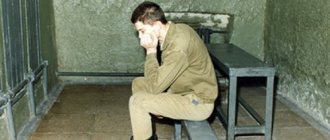Updated July 24, 2022 177 Author: Dmitry Petrov
Hello, dear readers of the KtoNaNovenkogo.ru blog. The desire to live in a legal environment is logical for any sane person.
The safety of life and the inviolability of private property depend on knowledge and compliance with the rules of law by all members of society (what is this?).
Every citizen needs to understand the basics of legal norms. Today we will look at what a crime is in a general sense, how this concept is interpreted by the Criminal Code (CC) of the Russian Federation, what categories and types of crimes are divided into depending on certain factors.
The concept of a criminal offense in the Russian Federation
The definition of an offense that is illegal is given in Art. 14 of the Criminal Code. In particular, its text says:
A crime is a socially dangerous act committed guilty of guilt, prohibited by this Code under threat of punishment.
So the action should be:
- dangerous to society;
- described in the paragraphs of the Criminal Code;
- carry the blame.
Moreover, the definition of a crime includes both active actions and their absence. After all, some types of inaction also pose a social danger. Therefore, any actions are persecuted, regardless of the degree of activity.
Attention: in Art. 8 of the Criminal Code states that the basis for criminal prosecution is an act containing elements of a crime. Thus, a new concept is introduced into the legal field. This is both a characteristic of the offense and a basis for prosecution.
A crime has signs. The main one is the social danger of the act . But knowing this fact is not enough to fully understand the issue. Criminal actions are comprehensively described in the articles of the Criminal Code (CC) of the Russian Federation. The text of the law is used by legal experts to classify offenses.
Important: an act that falls within the definition of a crime, but does not pose a public danger, is not punished (Article 14 of the Criminal Code). Download for viewing and printing:
Article 14 of the Criminal Code of the Russian Federation “The Concept of Crime”
Article 8 of the Criminal Code of the Russian Federation “Grounds of criminal liability”
Basics of forensic classification
Socially dangerous acts are classified. At the same time, various methods of dividing crimes into groups were used in criminology. For example, a common classification is:
- objects of influence;
- objective signs;
- subjective side (intentional, careless);
- subjects.
Nowadays it is customary to divide offenses according to their composition:
- simple, that is, falling under one article of the Criminal Code;
- complex, in which various violations of the law are highlighted.
For information: the following groups of offenses are distinguished by subject:
- committed individually or by a group;
- primary or repeated;
- by level of relationship with victims:
- there were special contacts;
- there were none;
- by age of offender:
- adult;
- minor.
Corpus delicti
In the legal field, a criminal offense is usually characterized. Its main distinguishing feature is its composition. This is understood as a set of descriptions, each of which carries an independent meaning. First of all, the features given in the definition are highlighted. That is, the socially dangerous nature of the offense, guilt and punishability .
The structure includes only those features that are characteristic of this particular type of dangerous act. They are called essential. In addition, alternative features are also identified. They are characteristic only of a certain type of illegal activity. Thus, the structure includes the following features:
- typical, characterizing a crime of this type;
- alternative, inherent only to a certain type of illegal activity.
Attention: the articles of the Criminal Code provide standard and alternative components of the structure of each act subject to legislative punishment.
Types of criminal offenses
When considering offenses, it is customary to classify their elements. The Criminal Code contains many different structures. They are divided by difficulty:
- simple;
- complex, that is, having a certain architecture.
Download for viewing and printing:
Article 15 of the Criminal Code of the Russian Federation “Categories of crimes”
Among the complex ones, various groups are also distinguished. Thus, the structure of the act can be homogeneous or combined. It may also have alternative signs. Based on these, structures are divided into:
- built according to the “either-or” scheme;
- combined by: objects;
- activities;
- consequences.
Attention: compositions are divided into formal and truncated.
The former fully fall within the description of the corresponding paragraph of the Criminal Code, the latter only partially coincide with the definition. In addition, it is customary to consider basic and additional compositions. They differ as follows:
- the main ones are understood as the features by which an act is defined as illegal;
- under additional, the punishment is differentiated.
Composition structure
The offense is characterized according to four main features. They are:
- object (who committed);
- subject (to whom it is directed);
- objective side;
- subjective.
Parsing an offense into its components helps classify it as punishable by law. Moreover, the constituent elements are those that describe each act of a separate type. For example, the object of an economic offense is relations in the economic sphere, and beatings are human health.
Hint: in addition to compositional elements, other characteristics are studied, called optional ones. They relate to a specific offense (circumstances of place and time, methods, etc.).
Classification by level of difficulty
In forensic theory, it is customary to divide common crimes according to their level of complexity. The main classification parameters are given in the table:
| Complexity | By objects | According to the consequences | In the form of guilt |
| Simple | Encroachment on one object | One act | One form |
| Complex | Some | Miscellaneous offenses | Some |
Complex compounds are divided into the following groups:
- Continuous, that is, consisting of a series of identical actions. They have a single goal and intent;
- Continuing is a violation of the law committed with intent that has a certain duration (storage of narcotic drugs, for example);
- Composite - a set of offenses is recognized as such, each of which is an independent violation of the law;
- With alternative components - an act consisting of parts. Each represents a completed crime.
Carelessness
A criminal violation of the law committed without unlawful intent is also considered unlawful. But this is characterized as negligence. Such a crime fully meets the elements of the crime with the exception of subjective characteristics. Caution: Carelessness is the absence of a pre-planned purpose.
What is a minor act?
When assessing the criminal’s actions, a full analysis is carried out, including the consequences. In this case, the act may be considered insignificant . This is a subjective assessment. It is used if all of its action features are not criminally punishable. Insignificance is described by the following elements:
- amount of damage;
- nature of actions;
- direction of action.
Attention: insignificance in law means the presence of a formal criminal offense, but the practical absence of public danger.
Bernard L. Madoff...$65 billion.
Organization: Bernard L. Madoff Investment Securities LLC
When: From the 1980s until Madoff's arrest in December 2008.
How: Bernard Lawrence Madoff committed one of the largest financial crimes in history using a Ponzi scheme, defrauding thousands of (mostly wealthy) investors. Almost $65 billion, including all of the fake "winnings" from this pyramid scheme, was lost. Many investors went broke. At least two people committed suicide, including French financier René-Thierry Magon de la Villehuchet, who lost his entire life savings and $1.4 billion of his client's money. He cut his wrists with a utility knife in his Manhattan office. Madoff became known as "The Most Hated Man in New York." Mark Madoff, the swindler's eldest son, hanged himself with a dog leash two years after his father's arrest, while his own two-year-old son slept nearby.
Sentence: 150 years in prison.
Features of signs of criminal attacks
In legal science, it is customary to identify several main signs of criminal actions. They are given in the definition given in Art. 14 of the Criminal Code. These include:
- danger to society;
- illegality;
- guilt.
Each element in the study of the situation is characterized and analyzed separately. In this case, it is customary to highlight the degree of one or another feature of criminal actions.
Public danger
The objects of criminal legal protection are given in the Constitution of the Russian Federation.
In the second article, the person’s personality is put in first place. In addition, society and the state are protected. Danger is a material sign of an act, which reveals its social essence. It is objective, that is, it exists regardless of value judgments. A danger to society is characterized by the following features:
- objective (for example, the degree of harm, its nature, the significance of the object, and so on);
- subjective (motivation, relapses).
Hint: the list of socially dangerous actions changes depending on changes in politics and economics.
Illegality
The articles of the Criminal Code describe actions that the law recognizes as prohibited. The illegality of an offense means that it is prohibited by current legislation . Consequently, when studying an offense, it is analyzed from the point of view of legal standards.
Guilt
It is customary in law to recognize guilt as a sign of an unlawful act. This is a subjective approach to the study of misconduct. That is, not only the offense itself is analyzed, but also the goal setting of the performer. Guilt implies the presence of criminal intent and its awareness by the offender. Attention: an innocent act does not exempt from liability (unintentional violation of the law).
Offense: examples and types
Crimes are an integral part of the life of modern society. A person is capable of breaking the law to achieve his own goal or obtain the necessary benefit. The reasons why a person commits an illegal act include various contradictions (political, social, religious, etc.), a low standard of living, or a discrepancy between needs and available opportunities. Illegal acts are committed not only by people in a hopeless situation, but also by mentally unbalanced individuals with various manic ideas and unhealthy inclinations.
Form of criminal behavior
Criminal law distinguishes two forms of committing offenses: action and inaction.
Each has distinctive features, but the common consequences are public danger. They are independent autonomous forms of offenses. And they have common specific characteristics. In law, action is defined as physical action, word and gesture. Each is committed with the aim of a criminal attack on a specific object. The most common in the paragraphs of the Criminal Code is physical force, beatings, for example.
Inaction is a passive form of encroachment. It consists of failing to do an act that a person is required by law to do. This can be sporadic or regular. For example, the negligence of an official who does not perform his duties.
Hint: Inaction has all the characteristics of a criminal offense.
Examples of civil responsibility from life
Find the civil offenses on the list and write down the numbers under which they are listed.
1) citizen N. exceeded the speed limit when entering the courtyard of the house
2) citizens of R. were renovating their apartment at night
3) citizen M. was unable to return the money borrowed from citizen N. within the prescribed period
4) the store refused to accept the defective dress she purchased from the customer
5) Citizen Sh. was late for work again, citing traffic jams on the highway.
6) the publishing house released an additional edition of the book without notifying the author and without paying him a fee
Composition of a civil offense (misdemeanor):
− illegal behavior, action (inaction) that violated the rights and obligations established by the norms of civil law;
− harm in civil law that can be caused to a person (moral harm) or property (damage, losses, material harm).
Examples of civil offenses are listed under the numbers 346
1, 2 administrative offense, 5 - disciplinary offense.
Generic objects of encroachment
The structure of the Criminal Code is drawn up taking into account the subject of the attacks. The degree of guilt and punishment are related to the generic object. This is what we call what a person’s criminal thoughts are aimed at. For example, the following generic objects are distinguished:
- life and health of the individual;
- society;
- state;
- own;
- peace and security of mankind.
The level of the generic object determines the degree of public danger. For example, a crime against health has one level of danger, but against humanity it has a completely different level.








